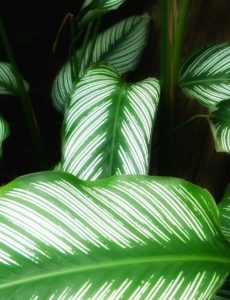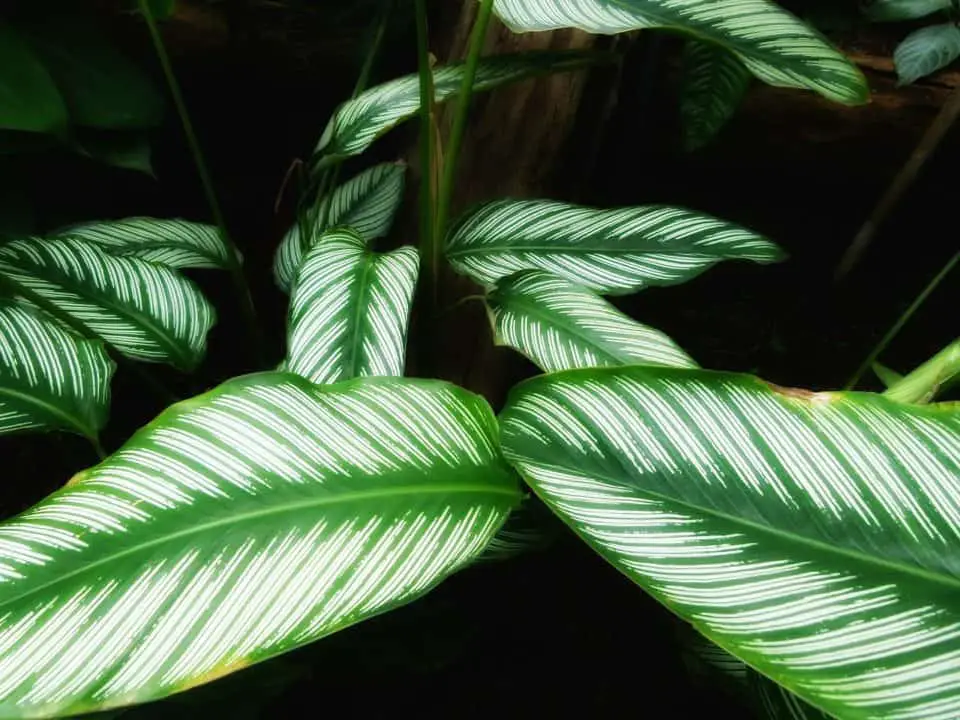Some links in the post are affiliate links and I get a commission from purchases made through some links found in the post.
Calathea Ornata, commonly called striped, pin-stripe, or pin-stripe Calathea, is a perennial plant species. It belongs to the family of prayer plants and is native to South America.
It is mostly cultivated in temperate countries as a houseplant. The plant is known for its large leaves having a characteristic pattern and effervescent colors.
The dark green leaves with signature pink/white stripes have a lasting impression. The undersides of young leaves look purple and turn green as the plant matures.
The leaves of this beautiful plant grow at the end of long stems. They require the right care and location in order to look healthy and fresh.
When grown indoors, Calathea ornata will not grow much larger than 3ft wide or 3ft tall. Outdoors, it reaches 9 feet in height.
This plant looks attractive indoors but is also kept outdoors and can bring many dull and dark areas to life.
Due to its striking foliage, this is an excellent plant to put among other plants that have large foliage. Also, if you’re used to over-watering your plants, this plant is right for you as it requires a lot of water.
Why are my Calathea Ornata Leaves Curling?
The visual impact makes Calathea Ornata stand out as an indoor plant. However, as with all plants, a problem that could arise with the calathea ornata is the curling of its leaves.
The main reason a calathea ornata leaves are curling are due to a deficiency of water. If your plants are watered inadequately (underwatering) and fall prey to your neglect, the leaves start showing signs of stress by curling up.
This curling is a coping process to prevent further water loss. Other causes of curling include too much bright sunlight exposure, low humidity, overwatering, root rot and overfertilizing.
How do you Uncurl Your Calathea Ornata Leaves?
 The common problem faced by the calathea ornata is the curling of its leaves. This problem arises from either underwatering, low humidity, or cold temperatures. To deal with drooping and curling leaves:
The common problem faced by the calathea ornata is the curling of its leaves. This problem arises from either underwatering, low humidity, or cold temperatures. To deal with drooping and curling leaves:
1) Water the plant with a generous soak. Let the excess water trickle from the base of the pot.
Ensure that the water has infiltrated the soil keeping it moist consistently throughout, and the roots can access the moisture.
2) Water your calathea as often as required so that the soil feels moist. Keep in mind your locality and environmental conditions so that you can water your plant according to the climate and the conditions of your home
3) Keep the plant away from draughts and air conditioning as this is not suitable for the plant.
Air currents draw moisture away from the leaves, causing them to curl and crisp. Place the plant in a nice, still place with bright, indirect light.
4) Calathea ornata prefers moist environments to grow as it is a tropical plant.
The plant cannot receive a tropical environment indoors, but we can try to maintain such artificial conditions suitable for growth. Use a humidifier or keep a humidifying tray underneath your plant to keep it healthy and the leaves moist.
5) Bear in mind that direct sunlight would not only cause your plant to curl but can also cause it to lose its variegation. So, it is a must to maintain the right conditions.
If you are enjoying this article, check out our article on why are my hydrangea leaves curling.
How Often Should I Water my Calathea Ornata?
The best approach to keeping Calathea ornata from curling is watering it as often and as required. To protect your Calathea ornata leaves from curling, try adopting a regular watering routine for your precious plant.
Ensure that the soil does not become completely dried out, nor does it become overly saturated.
The Calathea ornata is not a plant that fits the category drought-tolerant, so try to keep the top of the soil dried out slightly in between the waterings but do not let it dry completely.
Extended periods of dryness can cause the browning of your plant leaves, while overwatering causes the leaves to wilt.
In this under or over-watered state, the plant shows poor recovery from disease and other afflictions. Therefore, it is necessary to find a suitable watering schedule for your plant so that you can abide by a set of rules.
If you notice the browning and curling of your Calathea plant, it is a sure sign of underwatering, lack of humidity, and moisture.
It can also be due to sensitivity to fluoride or other chemicals in its water supply.
To rule out potential sensitivity to water chemicals, try to use distilled water for a few weeks. If curling improves, continue using distilled water for your plant.
In cases where you’re repotting or shifting your plant indoors, make sure to give the soil a good soaking and adequate water so that when you transfer your plant inside the pot, the leaves don’t get curled due to water or moisture deficiency.
Also, bear in mind not to overwater and puddle the soil with water. The plant needs to be moist and soaked, not completely wet and watery.
If you need help watering your plant, try using this automatic drip irrigation kit.
Why do Calathea Leaves Curl at Night?
 As it belongs to the prayer plant family and just like the maranta prayer plant, Calathea ornata’s leaves fold up at night as if they were hand in prayer.
As it belongs to the prayer plant family and just like the maranta prayer plant, Calathea ornata’s leaves fold up at night as if they were hand in prayer.
This allows the plants to show off their beautiful undersides. The main reason why the leaves respond this way is because the plant is photophilic, and the leaves’ position depends on the availability of light.
To gain light, the plant leaves take a horizontal position to soak up the sun.
In contrast, during the night, they assume a vertical standing position as there is no more light to be captured for photosynthesis, i.e., the process of fixing gases like CO2 to organic food with the help of light.
If your plant is showing curling or standing of its leaves at night, it shows that your plant is healthy.
It shows ill health, with signs of reduced water pressure inside the plant, indicating underwatering and malnourishment. Therefore, make sure to water your plant in routine adequately.
Another reason your plant might not be curling up its leaves at night is that it gets too much exposure to sunlight during the day or might be getting too much artificial light exposure.
This may interfere with its normal cyclic rhythm of leaf movement. Bright sunlight is already damaging to the plant, but too much exposure duration can leave the plant leaves confused on when to close and when to open due to an imbalance production of food.
Too much warmth and low humidity can also cause your plant’s movements to be disturbed. Low humidity deprives the plant of water and turgor, so do high temperatures.
The loss of turgor pressure, the water pressure inside the stems that cause the movement of plants, is crucial for the normal rhythmic movements of Calathea Ornata leaves.
Maintain temperature between 60-85°F for optimal growth of your plant. Watch out for spider mites feeding on your plant, as these might weaken your plant immensely.
How do I Revive a Calathea Ornata?
To bring your Calathea Ornata back to life, try to identify the cause of it dying first and then address the problem.
- If your plant is deprived of water, then try watering it. Adequate water supply daily for a couple of days would show you an improved plant. The plant leaves would gradually regain their strength and normal position.
- If lack of nutrients is the problem, then use a nitrogen fertilizer to replenish its nutrients. It is essential to maintain a steady supply of organic compounds to keep the plant healthy and alive.
- If lack of humidity is the reason behind its curling, use a humidifier tray or a humidifier device to maintain adequate moisture.
- Maintaining optimal temperature would also prompt its revival.
- Maintain optimal light supply and avoid direct sunlight. Calathea leaves look best when the plant is placed in bright indirect sunlight. The plant needs enough light for its variegated patterns.
Final Thoughts
 Calathea ornata is a tropical plant that requires moist conditions to grow adequately. Its leaves naturally curl up in the night as the leaves depend on the light source.
Calathea ornata is a tropical plant that requires moist conditions to grow adequately. Its leaves naturally curl up in the night as the leaves depend on the light source.
However, curling up in the daytime indicates inadequate watering. A low supply of water inhibits the normal photophilic movement.
A low supply of water also causes curling as a coping mechanism to prevent further water loss. Use a humidifier, maintain adequate temperatures, avoid direct sunlight and water regularly to revive your plant from curling.
It’s a good thing the plant is not toxic to pets and children. Using the right care and a keen eye for your plant will keep it healthy and make it last longer so that your indoors always stays classy.
Before you go, here are some more related articles I encourage you to read below to help solve more of your gardening issues:
Why are my croton leaves drooping.
What are the Common Problems With a Pilea
About the Author:
Saad Ansar
Saad is an avid gardener himself and is a great lover of plants, animals, photography, & people. Currently, he is focused on photographing indoor plants & captioning beautiful outdoor sceneries. He writes and rewrites in-depth articles on nature and science.

